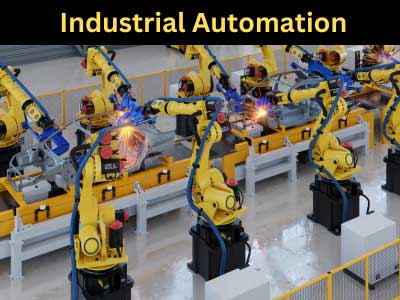What Are The Sensors For Factory Automation?
Key Takeaway

Types of Sensors
Sensors play a critical role in factory automation by providing the necessary data to control and optimize manufacturing processes. There are various types of sensors used in factory automation, each serving specific functions. Common types include proximity sensors, which detect the presence or absence of an object without physical contact, and photoelectric sensors, which use light to detect objects’ distance, presence, or absence. Another essential type is the temperature sensor, which monitors and controls the temperature in processes that require precise thermal management. Pressure sensors measure fluid and gas pressure, ensuring systems operate within safe and efficient parameters. Additionally, level sensors detect the level of substances within containers, while flow sensors monitor the movement of liquids and gases through a system. These sensors, among others, contribute to creating an integrated and responsive manufacturing environment.

Applications in Manufacturing
In manufacturing, sensors are indispensable for a wide range of applications. Proximity sensors are commonly used in assembly lines to detect parts’ position and presence, ensuring components are correctly aligned before proceeding to the next step. Photoelectric sensors are often found in packaging and sorting systems, where they help detect the presence of items on conveyor belts and ensure proper placement in packaging. Temperature sensors are crucial in processes like injection molding and metalworking, where maintaining the right temperature is vital for product quality and consistency. Pressure sensors are used in hydraulic and pneumatic systems to monitor and control pressure levels, preventing system failures and ensuring safety. Level sensors are critical in monitoring the levels of liquids and solids in tanks and silos, preventing overflows and ensuring consistent supply. Flow sensors are essential in applications such as chemical processing and water treatment, where accurate monitoring of fluid flow rates is necessary for maintaining process efficiency and safety.
Benefits of Using Sensors
The integration of sensors in factory automation offers numerous benefits that enhance efficiency, quality, and safety in manufacturing processes. One of the primary benefits is improved accuracy and precision in monitoring and controlling various parameters, leading to higher product quality and consistency. Sensors enable real-time data collection, allowing for immediate adjustments to processes, reducing downtime, and increasing overall productivity. By providing detailed insights into machine performance and process conditions, sensors facilitate predictive maintenance, helping to identify potential issues before they lead to costly breakdowns. This predictive capability minimizes unplanned downtime and extends the lifespan of equipment. Additionally, sensors improve safety by monitoring hazardous conditions and triggering automatic shutdowns or alerts to prevent accidents. The data collected by sensors also supports continuous improvement initiatives, enabling manufacturers to identify areas for optimization and implement more efficient processes.
Implementation Strategies
Successfully implementing sensors in factory automation requires a strategic approach to ensure they effectively contribute to process optimization and efficiency. The first step is to identify the specific needs and goals of the manufacturing process, determining which parameters need to be monitored and controlled. This involves selecting the appropriate types of sensors that can provide the necessary data. Once the sensors are chosen, it’s crucial to plan their placement carefully to ensure they capture accurate and relevant data. Integrating sensors with existing control systems, such as PLCs and SCADA systems, is essential for seamless data flow and real-time monitoring. Establishing a robust communication network, including wired or wireless connections, ensures that data is transmitted reliably to the control systems. Additionally, implementing data analytics tools can help process and interpret the collected data, providing actionable insights for decision-making. Regular calibration and maintenance of sensors are vital to maintaining their accuracy and reliability over time. Training employees on how to interpret sensor data and respond to alerts is also important for maximizing the benefits of sensor integration.
Case Studies
Several case studies illustrate the successful integration of sensors in factory automation, highlighting the benefits achieved through their implementation. One notable example is in the automotive industry, where a manufacturer integrated proximity sensors and vision systems in their assembly lines. This integration allowed for precise positioning and alignment of parts, reducing errors and increasing production speed. The real-time data provided by the sensors enabled immediate adjustments to be made, minimizing downtime and enhancing overall efficiency. In the food and beverage industry, a company implemented temperature and level sensors in their production processes. These sensors ensured that products were processed at optimal temperatures and that ingredient levels were maintained consistently, improving product quality and reducing waste. The integration of sensors also supported compliance with strict safety and quality regulations. In another case, a chemical processing plant used flow and pressure sensors to monitor their systems continuously. The sensors provided real-time data on flow rates and pressure levels, allowing for immediate adjustments to maintain safe and efficient operations. Predictive maintenance strategies based on sensor data helped the plant reduce unplanned downtime and extend the lifespan of their equipment.
Conclusion
Leveraging sensors in factory automation is essential for enhancing efficiency, quality, and safety in manufacturing processes. The integration of various types of sensors enables real-time monitoring and control of critical parameters, leading to improved accuracy, reduced downtime, and higher product quality. Implementing sensors strategically, from selecting the right types to ensuring proper placement and integration with control systems, is crucial for maximizing their benefits. Case studies from different industries demonstrate how sensors contribute to optimizing operations, supporting compliance with regulations, and enabling predictive maintenance. As technology continues to advance, the capabilities and applications of sensors in factory automation will expand, offering new opportunities for innovation and growth. By embracing sensor technology, manufacturers can create more responsive, efficient, and sustainable production environments, positioning themselves for success in a competitive market.
